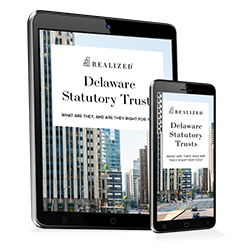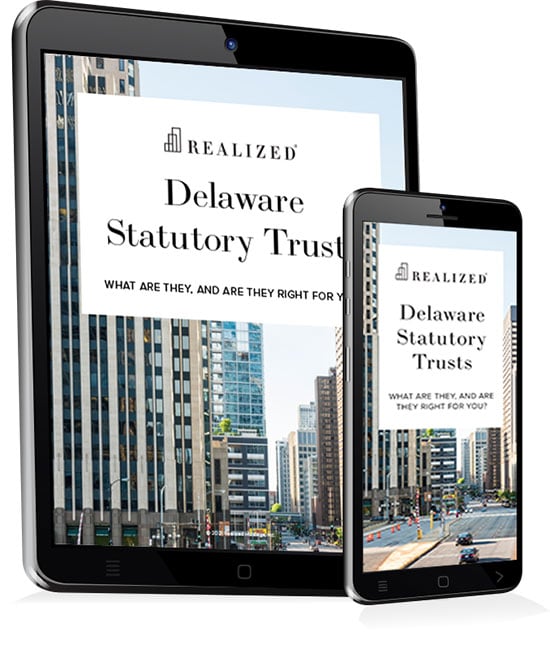
Among the many alternative investment options available today, Delaware Statutory Trusts or DSTs have gained popularity because of benefits like minimal investor involvement and truly passive income. When combined with 1031 Exchanges, DSTs also provide tax-deferral benefits that help investors preserve their capital. Even so, there are still those who are unsure regarding DSTs and their benefits, especially when traditional 1031 Exchanges are also a viable option.
In this article, Realized 1031 discusses in-depth the reasons why you should use a DST, highlighting key characteristics that make it a better option for some types of investors. Let’s dive in.
Defining Delaware Statutory Trusts
DSTs are an investment vehicle that allows investors, called the beneficial owners, to have fractional ownership of the trust. The trust, in turn, owns the property. The Delaware Statutory Trust Act created this structure, along with a few other characteristics.
- Fractional Ownership: Investors pool money into the DST in exchange for fractional ownership. With the substantial capital, DSTs can purchase properties that are usually out of reach for a single investor.
- Pass Through Entity: DSTs work as pass-through entities. This framework helps investors avoid double taxation as the DST will not be taxed on the corporate level.
- No Direct Involvement: For investors, no active management is required when joining a DST. The sponsor will handle the day-to-day operations and administration of the DST, creating a truly passive investment for the beneficial owners.
DSTs can own a wide range of assets, not just real estate. However, real property remains the popular option, especially as these types adhere to 1031 Exchange requirements. You’ll usually find DSTs owning multifamily homes, industrial facilities, commercial buildings, and even office spaces.
Key Advantage of DSTs
Why use a Delaware Statutory Trust? Many investors find DSTs appealing because of the following benefits.
Tax deferral
Revenue Ruling 2004-86 provided language that made DSTs eligible for 1031 Exchanges. This means that you can exchange proceeds from a property sale for fractional interests in a DST and delay payment for capital gains taxes, which may assist investors in preserving and potentially growing their invested capital.
Minimal Involvement
To maintain the tax-deferred status, DSTs must adhere to rules such as investors having no control over the day-to-day management of the property. These limitations are a boon for investors who no longer want direct involvement in their assets. As a result, investors receive distributions—if and when made—without assuming operational responsibilities.
Access to Institutional-grade Assets
Since investors pool money, DSTs can own high-value properties that might otherwise be inaccessible to a single investor. These assets are professionally managed and may generate income, which is typically distributed to beneficial owners in accordance with their ownership interests and subject to the trust’s financial performance.
Protection Against Personal Liability
The DST framework adds another level of protection for investors by limiting liability to the trust. As such, if the DST is unable to fulfill some financial obligation, creditors can only come after the investment you placed in the trust, not your personal assets.
Investment Minimums and Diversification Opportunities
Purchasing or exchanging into investment properties can require substantial capital, which may limit access for some investors. Many DST offerings establish minimum investments that are lower than those typically required for whole-property acquisitions, with some as low as $100,000. These thresholds may allow eligible investors to allocate proceeds across multiple DSTs, potentially gaining exposure to different property sectors and geographic markets as part of a diversified real estate strategy.
Key Risks of DSTs
While Delaware Statutory Trusts (DSTs) offer a number of potential benefits, they are also subject to a range of risks and limitations. It’s essential that investors understand these factors before committing capital.
Illiquidity
DST interests are not publicly traded, and there is typically no secondary market. Investors should be prepared to hold their interest for the entire term of the DST, which often ranges from 5 to 10 years. Early exit options are extremely limited, and liquidity is not guaranteed.
Lack of Control
To qualify, investors must remain passive participants. This means they cannot influence management decisions, property operations, refinancing, or sales timing. While this hands-off structure benefits some investors, others may find the lack of decision-making authority restrictive.
Market and Property-Specific Risks
Like all real estate investments, DSTs are exposed to market fluctuations, tenant risk, property damage, and economic downturns. If the underlying property underperforms, rental income and eventual return of capital may be adversely affected.
Loss of Tax Deferral Eligibility
If the DST structure fails to comply with IRS requirements, investors may lose eligibility for 1031 tax deferral. This could trigger recognition of capital gains in the year of the transaction.
Concentration Risk
DST investments often involve exposure to a single asset or property type, such as multifamily, medical office, or industrial. If an investor is not diversified across sectors or regions, their portfolio may be vulnerable to localized risks.
Interest Rate and Financing Risk
Some DSTs are leveraged. Rising interest rates or changes in loan terms can affect cash flow or impact property values. Additionally, investors typically have no input into financing decisions.
Minimum Investment and Accredited Investor Requirements
DSTs are usually offered through private placements under SEC Regulation D, meaning they are limited to accredited investors and carry minimum investment thresholds. These restrictions may limit availability and accessibility.
Fee and Expense Structures
DST offerings often involve multiple layers of fees and costs, including acquisition fees, asset management fees, and disposition fees. These can reduce the net return to investors and should be carefully reviewed in the Private Placement Memorandum (PPM).
Comparing DSTs vs Traditional 1031 Exchanges
When considering how to defer capital gains taxes through a real estate sale, two primary options stand out: the traditional 1031 exchange and the DST. Here’s how the two compare.
Ease of Replacement Property
- 1031 Exchange: Investors must identify and close on a like-kind property within strict IRS deadlines (45 days to identify, 180 days to close). Finding a suitable property of equal or greater value can be time-consuming and competitive.
- DST: DSTs are pre-structured offerings that can accept multiple investors. This often makes the reinvestment process more streamlined, especially when time constraints are a concern.
Extent of Management
- 1031 Exchange: In a traditional exchange, you have direct ownership of the replacement property. This means that you’ll also have full responsibility over its operations and management.
- DST: Since sponsors are the only party allowed to manage DST properties, investors don’t have to endure the burden of management.
Diversification
- 1031 Exchange: Due to the capital required to acquire whole properties, diversification may be more difficult without significant assets.
- DST: By dividing your proceeds and investing in multiple DSTs, you can diversify your portfolio across more sectors.
Liquidity
- 1031 Exchange: While real property is inherently illiquid, owners retain the ability to sell at their discretion (subject to tax implications). However, a short holding period may draw IRS scrutiny if intent to hold as an investment is unclear.
- DST: These investments are illiquid, especially with the holding period that usually lasts five to seven years or more. Plus, there is a limited secondary market if you plan to sell your fractional interests.
Control
- 1031 Exchange: Since you have direct ownership of the replacement property, you retain full control of everything, from major capital improvements to tenant selection.
- DST: Investors must remain passive to qualify for tax deferral under §1031. All operational decisions are handled by the sponsor or trustee. This structure may not suit investors who desire a more hands-on role.
Final Thoughts: Why Use a DST?
Many investors find DSTs appealing because of benefits like passive income, professional management, and access to institutional-grade assets. When combined with 1031 Exchanges, you can also enjoy potential tax-deferral benefits. If you’re an investor who wants these benefits as part of their overall strategy, DSTs may become a suitable option.
The tax and estate planning information offered by the advisor is general in nature. It is provided for informational purposes only and should not be construed as legal or tax advice. Always consult an attorney or tax professional regarding your specific legal or tax situation.
Article written by: Story Amplify. Story Amplify is a marketing agency that offers services such as copywriting across industries, including financial services, real estate investment services, and miscellaneous small businesses.
Cited Sources:
https://smartasset.com/investing/delaware-statutory-trusts-dsts



